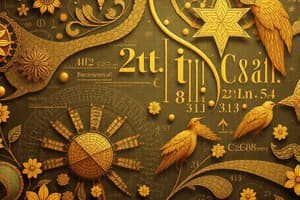Podcast
Questions and Answers
Which property of arithmetic indicates that changing the order of numbers does not change the result?
Which property of arithmetic indicates that changing the order of numbers does not change the result?
- Associative property
- Commutative property (correct)
- Distributive property
- Identity property
What type of function is represented by the equation $f(x) = ax^2 + bx + c$?
What type of function is represented by the equation $f(x) = ax^2 + bx + c$?
- Linear function
- Quadratic function (correct)
- Polynomial function
- Exponential function
In trigonometry, what does the sine of an angle represent in a right triangle?
In trigonometry, what does the sine of an angle represent in a right triangle?
- Hypotenuse over adjacent side
- Opposite side over hypotenuse (correct)
- Opposite side over adjacent side
- Adjacent side over hypotenuse
What is the significance of derivatives in calculus?
What is the significance of derivatives in calculus?
Which of the following measures is used to find the center of a data set?
Which of the following measures is used to find the center of a data set?
Which area of mathematics focuses on counting principles and arrangements?
Which area of mathematics focuses on counting principles and arrangements?
What does mathematical modeling involve?
What does mathematical modeling involve?
Which mathematician is known for laying the foundations of geometry?
Which mathematician is known for laying the foundations of geometry?
Flashcards are hidden until you start studying
Study Notes
Key Areas of Mathematics
-
Arithmetic
- Basic operations: addition, subtraction, multiplication, division.
- Properties: commutative, associative, distributive.
-
Algebra
- Variables and expressions: understanding symbols and terms.
- Equations and inequalities: solving for unknowns.
- Functions: linear, quadratic, polynomial functions.
-
Geometry
- Shapes and properties: triangles, circles, polygons, solids.
- Theorems: Pythagorean theorem, congruence, similarity.
- Area and volume calculations.
-
Trigonometry
- Ratios: sine, cosine, tangent.
- Right triangles: relationships and properties.
- Unit circle and its applications.
-
Calculus
- Limits: understanding behavior of functions.
- Derivatives: rates of change and slopes of curves.
- Integrals: area under curves and accumulation of quantities.
-
Statistics
- Data collection and analysis: mean, median, mode.
- Probability: basic concepts, rules, and distributions.
- Inferential statistics: hypothesis testing, confidence intervals.
-
Discrete Mathematics
- Combinatorics: counting principles, permutations, combinations.
- Graph theory: vertices, edges, paths, and cycles.
- Logic: propositions, logical connectives, truth tables.
Mathematical Concepts
-
Number Systems
- Natural numbers, whole numbers, integers, rational numbers, irrational numbers, real numbers, complex numbers.
-
Mathematical Proofs
- Inductive reasoning, deductive reasoning, direct proof, proof by contradiction.
-
Mathematical Modeling
- Using mathematics to represent real-world situations to make predictions or decisions.
Applications of Mathematics
-
In Science and Engineering
- Modeling physical systems, analyzing data, optimizing processes.
-
In Economics and Finance
- Analyzing trends, calculating interest, understanding risk.
-
In Computer Science
- Algorithms, data structures, cryptography.
Important Figures in Mathematics
- Euclid: geometry and the foundations of mathematical proofs.
- Isaac Newton: calculus and the laws of motion.
- Carl Friedrich Gauss: number theory and statistics.
Study Tips
- Practice problem-solving regularly.
- Relate concepts to real-life applications for better understanding.
- Collaborate with peers for discussions and group studies.
Key Areas of Mathematics
- Arithmetic: Involves basic operations such as addition, subtraction, multiplication, and division, with properties including commutative, associative, and distributive laws.
- Algebra: Focuses on variables, expressions, and the solving of equations and inequalities, as well as working with functions like linear, quadratic, and polynomial.
- Geometry: Studies shapes such as triangles, circles, polygons, and solids, along with key theorems including the Pythagorean theorem and concepts of congruence and similarity, plus area and volume calculations.
- Trigonometry: Examines ratios like sine, cosine, and tangent, particularly in the context of right triangles, and utilizes the unit circle for various applications.
- Calculus: Encompasses limits to analyze the behavior of functions, derivatives to understand rates of change, and integrals which calculate the area under curves and the accumulation of quantities.
- Statistics: Involves data collection and analysis techniques such as calculating mean, median, and mode, alongside foundational concepts in probability and inferential statistics for hypothesis testing and confidence intervals.
- Discrete Mathematics: Covers combinatorics (counting principles, permutations, combinations), graph theory (vertices, edges, paths, cycles), and logical reasoning (propositions, logical connectives, truth tables).
Mathematical Concepts
- Number Systems: Includes various classifications such as natural numbers, whole numbers, integers, rational, irrational, real, and complex numbers.
- Mathematical Proofs: Involves methods like inductive and deductive reasoning, direct proofs, and proofs by contradiction to establish mathematical truths.
- Mathematical Modeling: The use of mathematical frameworks to represent real-world situations allows for making predictions and informed decisions.
Applications of Mathematics
- In Science and Engineering: Mathematics is used for modeling physical systems, data analysis, and process optimization.
- In Economics and Finance: It aids in analyzing trends, calculating interest, and understanding risk assessment.
- In Computer Science: Involves the development of algorithms, data structures, and applications in cryptography.
Important Figures in Mathematics
- Euclid: Known for foundational contributions to geometry and establishing methods of mathematical proofs.
- Isaac Newton: Revolutionized calculus and formulated the laws of motion.
- Carl Friedrich Gauss: Made significant contributions to number theory and statistics.
Study Tips
- Engage in regular practice to enhance problem-solving skills.
- Connect mathematical concepts to real-life situations for improved comprehension.
- Collaborate with peers for enriched discussions and effective group studies.
Studying That Suits You
Use AI to generate personalized quizzes and flashcards to suit your learning preferences.




